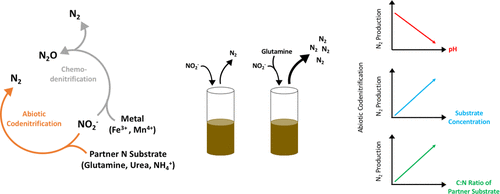当前位置:
X-MOL 学术
›
ACS Earth Space Chem.
›
论文详情
Our official English website, www.x-mol.net, welcomes your feedback! (Note: you will need to create a separate account there.)
Determining Chemical Factors Controlling Abiotic Codenitrification
ACS Earth and Space Chemistry ( IF 3.4 ) Pub Date : 2021-01-15 , DOI: 10.1021/acsearthspacechem.0c00225 Stephanie J. Wilson 1 , Bongkeun Song 1 , Rebecca L. Phillips 2, 3
ACS Earth and Space Chemistry ( IF 3.4 ) Pub Date : 2021-01-15 , DOI: 10.1021/acsearthspacechem.0c00225 Stephanie J. Wilson 1 , Bongkeun Song 1 , Rebecca L. Phillips 2, 3
Affiliation

|
Codenitrification is a reactive nitrogen (N) removal pathway producing hybrid dinitrogen (N2) by combining nitrite (NO2–) and a partner-N substrate. Abiotic codenitrification also produces hybrid N2 through nitrosation of organic N by NO2–, but it is poorly constrained in soil N cycles. We determined the importance of abiotic codenitrification in soils and examined factors controlling abiotic codenitrification using live soils, sterile soils, and sterile solutions. Abiotic codenitrification in sterile soils ranged from 0.12 ± 0.001 to 0.60 ± 0.08 nmoles 29N2-N g–1 day–1, which accounts for 2.3 to 8.2% of total N2 production measured in live soils. Increased abiotic N2 production was observed in soils with the addition of an organic N partner (glutamine). Consistent with previous work, higher rates were observed in lower-pH soils, but the highest rate was found in the soil with the highest carbon:nitrogen (C:N) ratio. We further investigated a range of organic N partners and the influence of concentration and pH on abiotic codenitrification in solution. Similar to sterile soil incubations, abiotic 29N2 production was negatively correlated with increasing pH in solution. Greater rates of abiotic 29N2 production were measured as the substrate concentration increased and pH decreased. Solution experiments also showed that addition of organic N partners increased abiotic codenitrification rates, which are positively correlated with the C:N ratios of organic N partners. This is the first study demonstrating the importance of N removal through abiotic codenitrification in acidic soils and the C:N ratio of organic N partners as a controlling factor in abiotic codenitrification.
中文翻译:

确定控制非生物共硝化的化学因素
Codenitrification是活性氮(N)移除路径中产生杂种二氮(N 2通过组合亚硝酸盐(NO)2 - )和一伙伴-N衬底。非生物codenitrification也产生杂合N- 2通过的有机氮亚硝化由NO 2 - ,但它是在土壤N个周期约束较差。我们确定了非生物共硝化在土壤中的重要性,并研究了使用活性土壤,无菌土壤和无菌溶液控制非生物共硝化的因素。无菌土壤中的非生物共氮化作用范围从0.12±0.001到0.60±0.08 nmoles 29 N 2 -N g –1天–1,占活土壤中N 2总产量的2.3%至8.2%。在土壤中添加有机氮伙伴(谷氨酰胺)可以增加非生物氮2的产生。与以前的工作一致,在pH值较低的土壤中观察到了较高的比率,但在碳/氮(C:N)比最高的土壤中发现了最高的比率。我们进一步研究了一系列有机氮伙伴以及浓度和pH对溶液中非生物共硝化的影响。与无菌土壤培养相似,非生物29 N 2的产生与溶液中pH的增加呈负相关。非生物性29 N 2的比率更高随着底物浓度的增加和pH值的降低来测量产量。溶液实验还表明,添加有机氮伙伴增加了非生物共硝化率,这与有机氮伙伴的C:N比正相关。这是第一项研究,证明了在酸性土壤中通过非生物共硝化去除氮的重要性以及有机N伙伴的C:N比作为非生物共硝化的控制因素。
更新日期:2021-02-18
中文翻译:

确定控制非生物共硝化的化学因素
Codenitrification是活性氮(N)移除路径中产生杂种二氮(N 2通过组合亚硝酸盐(NO)2 - )和一伙伴-N衬底。非生物codenitrification也产生杂合N- 2通过的有机氮亚硝化由NO 2 - ,但它是在土壤N个周期约束较差。我们确定了非生物共硝化在土壤中的重要性,并研究了使用活性土壤,无菌土壤和无菌溶液控制非生物共硝化的因素。无菌土壤中的非生物共氮化作用范围从0.12±0.001到0.60±0.08 nmoles 29 N 2 -N g –1天–1,占活土壤中N 2总产量的2.3%至8.2%。在土壤中添加有机氮伙伴(谷氨酰胺)可以增加非生物氮2的产生。与以前的工作一致,在pH值较低的土壤中观察到了较高的比率,但在碳/氮(C:N)比最高的土壤中发现了最高的比率。我们进一步研究了一系列有机氮伙伴以及浓度和pH对溶液中非生物共硝化的影响。与无菌土壤培养相似,非生物29 N 2的产生与溶液中pH的增加呈负相关。非生物性29 N 2的比率更高随着底物浓度的增加和pH值的降低来测量产量。溶液实验还表明,添加有机氮伙伴增加了非生物共硝化率,这与有机氮伙伴的C:N比正相关。这是第一项研究,证明了在酸性土壤中通过非生物共硝化去除氮的重要性以及有机N伙伴的C:N比作为非生物共硝化的控制因素。


























 京公网安备 11010802027423号
京公网安备 11010802027423号